November 12, 2013 – The BMW S 1000 R is the new high-performance roadster based on the BMW S 1000 RR (report).
Superbike riding dynamics and powerful, emotive roadster styling are the hallmarks of the new BMW S 1000 R.
The new bike from BMW Motorrad is directly derived from the S 1000 RR superbike and uses the same innovative technology.
The close family resemblance to the RR is instantly obvious. The pared down appearance of the new S 1000 R exudes an aggressive, dynamic energy.
Based on a well-thought-out overall concept, with 160 hp maximum power and a weight of 207 kg, as well as Race ABS, ASC and a choice of two riding modes as standard, the BMW S 1000 R sets new standards in the sports roadster segment.
In-line four-cylinder engine with optimized low to mid-range performance.
When modifying the S 1000 RR’s 999 cc four-cylinder in-line engine for use in the S 1000 R, the engineers were looking in particular to provide punchy response all the way through the rpm range.
To provide the ideal set-up both for everyday use and for sporty riding on the open road, they significantly increased the low and mid-range power and torque.
At the same time, maximum rpm has been reduced by approximately 2,000 rpm.
Maximum power of 118 kW (160 hp) is reached at 11,000 rpm and peak torque of 112 Nm (approx. 83 lb-ft) at 9,250 rpm.
Up to 7500 rpm, this engine version develops 10 Newton meters (approx. 7 lb-ft) more torque than the S 1000 RR.
This provides punchy low-end response that is ideal on twisty single-carriageway roads.
Among other things, this was achieved by using redesigned cylinder head ducts, modified cam profiles and appropriately modified engine management. The new BMS-X engine management system also supports an E-Gas “throttle-by-wire” system.
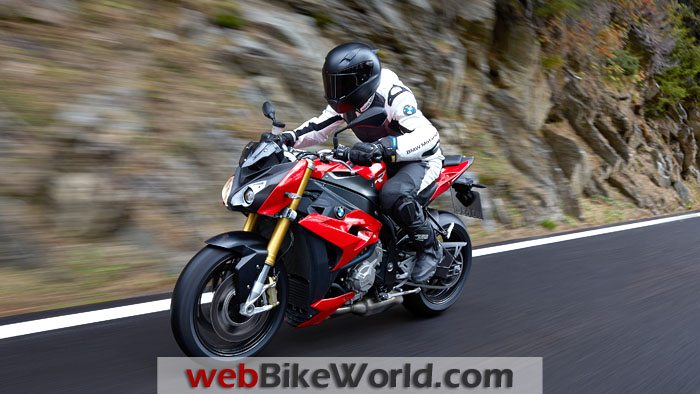
ASC (Automatic Stability Control), Race ABS and a choice of two riding modes as standard.
Riding mode Pro with two additional modes and DTC optionally available.
For optimal adaptation to different conditions and rider requirements, the S 1000 R comes with two riding modes and ASC (Automatic Stability Control) as standard.
The “Rain” and “Road” modes cater to different road surface conditions using different power and torque curves, and applying different levels of Race ABS and ASC intervention.
This provides an important safety bonus, particularly under changeable road conditions.
Dynamic Traction Control (DTC), incorporating a further two riding modes — “Dynamic” and “Dynamic Pro” — is available as an ex-works option.
This option allows riders to make the most of the S 1000 R’s sporty performance potential both on the road and on the race track.
Dynamic Traction Control, which includes a banking angle sensor, offers safe and dynamic acceleration which is currently state-of-the-art for a production motorcycle.
Innovative chassis and suspension technology with large damping reserves and high-performance brakes.
Dynamic Damping Control (DDC) optionally available. However ambitious the riding style, the chassis and suspension of the S 1000 R is a match for the dynamic power delivery of the four-in-line engine.
Based on that of the S 1000 RR, it uses the proven aluminum alloy perimeter frame, in which the engine forms part of the load-bearing structure.
As on the RR, an adjustable upside-down fork and a dual swingarm with adjustable central spring strut guide the wheels front and rear. Roadster-specific suspension requirements are met by a slight change in geometry.
As on the RR, vigorous, stable and above all safe braking is provided by a braking system that comprises a twin-disc brake with two radial 4-piston fixed calipers at the front and a single-disc brake at the rear, with partially integral Race ABS.
Dynamic Damping Control (DDC), available as an ex-works optional extra, offers the benefits of electronic damping control.
For further enhanced performance, in combination with enhanced active safety, this system dynamically adapts the damping to the current riding situation with split-second speed.
Multifunctional instrument cluster.
Last but not least, race-inspired features also extend to the cockpit of the S 1000 R.
With an LC display with analogue rev counter, the instrumentation offers an unrivalled amount of information in this segment, from the gear display and riding mode display to a lap timer.
For optimal gear changes, an individually programmable quick-shifter is fitted.
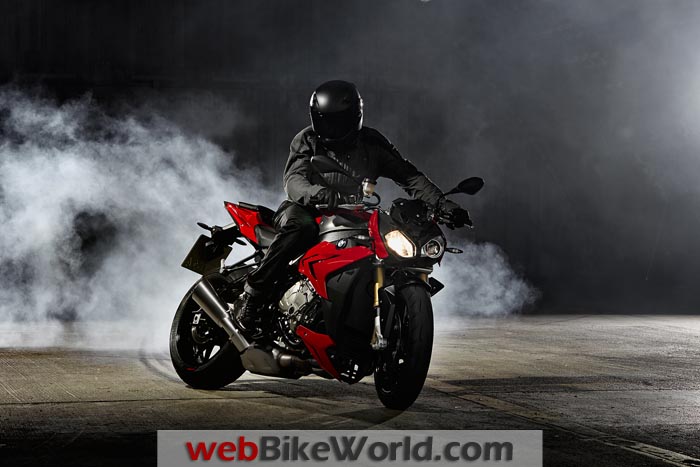
Highlights of the new BMW S 1000 R:
- Pared down styling with an aggressively dynamic look; clear family similarities with S 1000 RR.
- Liquid-cooled 999 cc four-cylinder in-line engine.
- Max. power 118 kW (160 hp) at 11,000 rpm, max. torque 112 Nm (approx. 83 ft-lb) at 9,250 rpm.
- 207 kg curb weight with full fuel tank.
- Standard-fitted Race ABS for superior braking performance and safety.
- Standard-fitted ASC (Automatic Stability Control) for safe acceleration on surfaces with variable grip.
- Standard-fitted steering damper.
- Choice of two standard, rider-selectable riding modes, “Rain” and “Road”.
- Optional Dynamic Traction Control DTC including Riding mode Pro maximizes both riding enjoyment and active safety in all road situations.
- Optional Riding mode Pro comprising two additional riding modes — “Dynamic” and “Dynamic Pro” — for road and track use.
- Full synchronization of Race ABS, ASC/ DTC, DDC and engine management.
- Innovative exhaust system with small rear silencer, front silencer, electronically controlled exhaust flap and two closed-loop, three-way catalytic converters.
- E-Gas system for optimal throttle control and maximum reliability.
- Suspension components with large damping reserves.
- DDC (Dynamic Damping Control): electronically controlled damping system for optimal, dynamic adaptation of damping to the current riding situation and to the load the bike is carrying.
- Aluminum fuel tank brings further weight savings and is unique in this segment.
- Infectious handling with highest standards of stability at high speeds and when braking.
- Multifunctional instrument cluster with extensive range of features.
- Extensive equipment and tailored accessories conforming to the customary high BMW Motorrad standards.
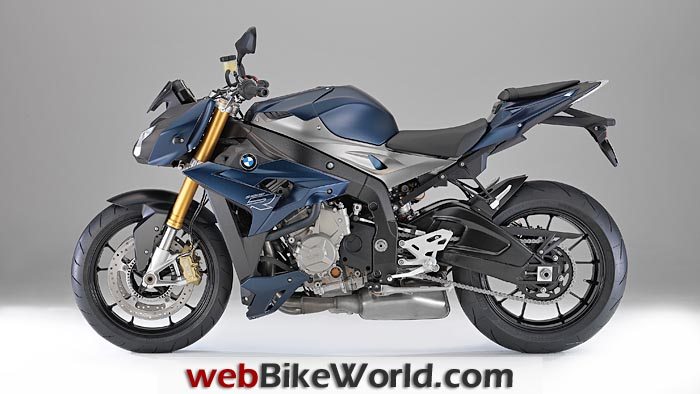
Drivetrain.
The S 1000 RR, which made its debut in 2009, was the first out-and-out superbike from BMW Motorrad to be powered by a four-cylinder in-line engine. It marked something of a turning point in this segment.
Quickly dubbed the “RR” in the motorcycling community, the 142 kW (193 hp) superbike set new benchmarks in terms of performance.
But with technical innovations like Dynamic Traction Control (DTC), the track-capable ABS system Race ABS and a choice of rider-selectable riding modes, it also set new standards of riding dynamics in this category.
With the S 1000 R, BMW Motorrad has now taken the next logical step and tailored this innovative technology package to the sports roadster segment.
Based on a well-thought-out overall concept with maximum power of 160 hp and a weight of 207 kg, and equipped with Race ABS, ASC and a choice of two riding modes as standard, the S 1000 R sets new standards in the sports roadster segment.
Its effortless handling and highest levels of performance and dynamics go hand in hand with powerful emotional appeal.
BMW S 1000 R engine specifications.
The in-line four-cylinder engine of the new BMW S 1000 R shares many of the features of the engine that powers the S 1000 RR superbike.
In the S 1000 R, however, this engine has been optimized to achieve the best fit with the requirements of a roadster.
In this version, the four-in-line engine develops maximum power of 118 kW (160 hp) at 11,000 rpm and maximum torque of 112 Nm at 9,250 rpm.
To provide the punchy response all the way through the rpm range that is required for sporty riding on typical single-carriageway roads, torque has been increased.
Up to 7,500 rpm, the S 1000 R’s engine offers up to 10 Newton meters (approx. 7 lb-ft) more torque than the S 1000 RR, which is tailored more to maximized power and track performance.
Once again, the 999 cc four-cylinder in-line engine, which has a bore/stroke ratio of 49.7 to 80 millimeters, uses a valvetrain with small, lightweight single rocker arms.
In combination with a short, toothed, sprocket-driven camshaft timing chain, this provides maximum rpm stability and precise valve timing.
As on the S 1000 RR, mixture formation is based on fully sequential, cylinder-selective fuel injection with two injectors per cylinder.
For use in the S 1000 R, the high-performance engine incorporates a number of modifications.
For even better low and mid-range volumetric efficiency, the cylinder head ducts have been redesigned and the valve lift curves have been modified.
Maximum rpm is around 2,000 rpm lower than on the S 1000 RR, at 12,000 rpm.
The bike also uses the new BMS-X engine management system (S 1000 RR: BMS-KP), which supports a full E-Gas throttle-by-wire system.
As on the S 1000 RR, cylinder-selective anti-knock control is also featured. Ignition coils with integrated igniter and new sensors for both overhead camshafts are further modifications on the engine electrics and electronics front.
The high-grade stainless-steel exhaust system incorporating an exhaust flap with reduced weight and enhanced acoustics meets the most stringent noise and emissions standards without sacrificing power output.
It also includes a small, attractively styled rear silencer.
As on the S 1000 RR, on the S 1000 R the power is managed by a constant mesh six-speed gearbox and an O-ring roller chain.
The S 1000 R, too, can be equipped with the optional HP Gear Shift Assistant, which allows clutchless upshifting with minimal torque interruption.
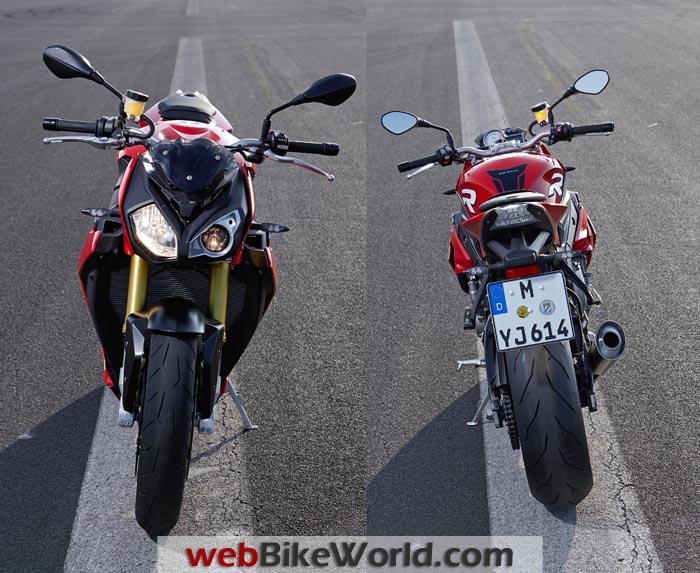
Automatic Stability Control (ASC), Race ABS and two riding modes as standard.
The S 1000 R comes with two riding modes and ASC (Automatic Stability Control) as standard, for optimal adaptation to different conditions and rider requirements.
The standard “Rain” and “Road” modes allow the S 1000 R’s riding characteristics to be matched to road conditions.
The likewise standard-fitted, partially integral Race ABS, together with ASC, significantly increase the sporty roadster’s versatility and provide an important safety and performance bonus, particularly under changeable road conditions.
These functions can be activated or disengaged on the fly.
In “Road” mode, Race ABS and ASC are set up for dry road conditions and optimal throttle response is ensured. In “Rain” mode, the bike is set up for low-grip road conditions, particularly for wet weather.
Throttle response is softer and Race ABS and ASC intervene sooner, in line with the conditions.
In this mode, maximum power is limited to BMW Media information 11/2013 Page 7 100 kW (136 hp) at 9,500 rpm and torque to 104 Nm (approx. 77 lb-ft) at 9,000 rpm.
The Riding mode Pro option adds two further riding modes, “Dynamic” and “Dynamic Pro”, on top of the standard specification.
Riding mode Pro is included in the DTC (Dynamic Traction Control) option and also in the optional Sports Package. In conjunction with Riding mode Pro, the standard ASC is replaced by DTC with integrated banking angle sensor.
The “Dynamic” mode is designed for sporty operation on dry roads. The engine is set up for direct throttle response and the Race ABS thresholds are higher. Rear-wheel lift-off detection is disabled as well, while the Dynamic Traction Control (DTC) thresholds are higher for a more dynamic riding style.
The “Dynamic Pro” mode (activated by a coding plug) is intended for extra-sporty riding on dry roads.
In this mode, Race ABS operates without rear wheel lift-off detection and does not intervene in rear-wheel braking. This allows experienced riders to drift into bends.
DTC interventions are likewise set up for extra-sporty riding in high-grip conditions. The front wheel lift-off detection allows for wheelies, which are up to the rider to control.
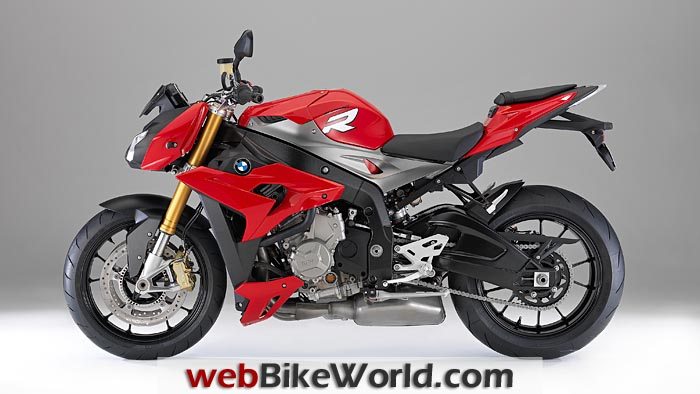
Chassis and suspension.
Like its engine and electronic control systems, the BMW S 1000 R’s chassis and suspension are based on the proven technology of the S 1000 RR, too.
The chassis design is centered on the aluminum perimeter frame which weighs just 11.98 kg and incorporates the 32-degree, forward-inclined engine as part of its load-bearing structure.
With a curb weight of 207 kg with full fuel tank, the new S 1000 R is one of the lightest bikes in its category.
This alone, however, goes only part-way towards explaining the S 1000 R’s effortless handling, excellent balance and precise riding characteristics.
More significant in this respect are the optimized center of gravity achieved through extensive testing and the suspension geometry.
For example, the castor angle of 65.4 degrees is 0.8 degrees more raked and the trail of 98.5 millimeters is 5 millimeters longer than on the RR.
Wheelbase has been increased by 22 millimeters to 1,439 millimeters. All these measures not only increase traction and stability but also steering response and comfort.
As on the RR, the front wheel is located by an upside-down fork with 46-mm-diameter fixed tubes.
The upside-down fork features inner cartridge inserts, i.e. a separate hydraulic piston-cylinder system which allows compression and rebound damping to be adjusted.
If the optional DDC is specified, spring preload too can be adjusted. Total front-wheel suspension travel is 120 millimeters, the same as at the rear, with 70 millimeters of positive and 50 millimeters of negative travel.
The S 1000 R’s rear-wheel location likewise contributes to the excellent riding dynamics, featuring a central spring strut with adjustable spring preload and adjustable compression-stage damping.
The spring strut is located by a compact, lightweight kinematic system. Total rear-wheel suspension travel is 120 millimeters, with 80 millimeters of positive and 40 millimeters of negative spring travel.
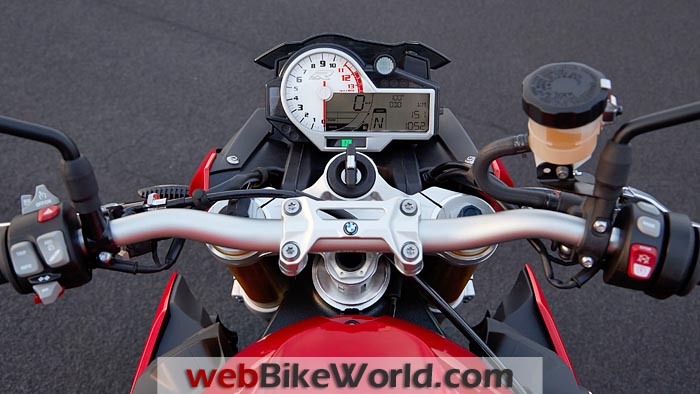
Optional Dynamic Damping Control (DDC) with three settings.
The excellent suspension quality already offered by the S 1000 R in standard specification can be further increased with the Dynamic Damping Control system (DDC), first introduced on the HP4 in 2012.
With this system, the compression and rebound damping stages are linked to the relevant riding mode.
They are additionally adapted dynamically to the current riding situation, for example to fast steering changes on a series of bends or to uneven road surfaces.
This electronic damping control system responds automatically to maneuvers like braking, accelerating or cornering, and to changes in road conditions, adapting the damping by means of electronically controlled damping valves.
The basic settings of the Dynamic Damping Control system (DDC) are synchronized with the “Rain”, “Road”, “Dynamic” and “Dynamic Pro” modes, which are conveniently selectable by the rider at the press of a button.
In “Rain” and “Road” mode, the DDC set-up provides the plush, comfortable damping most suitable for operation on typical single-carriageway roads, whether on poor or good surfaces.
In “Dynamic” mode, the damping provides a certain amount of tautness, while in “Dynamic Pro” mode the DDC set-up is more closely geared to maximized performance and supports a very sporty riding style, whether on the road or on the track.
The taut damping gives the rider crystal-clear feedback on the riding situation at all times.
The damping settings can be adjusted when the bike is stationary or on the move.
The adjustment is implemented in fractions of a second by an electronically controlled valve with variable annular gap, which varies the flow cross-section for the damping oil. This ensures optimal compression and rebound damping in all riding situations.
Compromises on suspension set-up are therefore a thing of the past.
At the same time the DDC also provides maximum traction for optimal translation of engine power into acceleration.
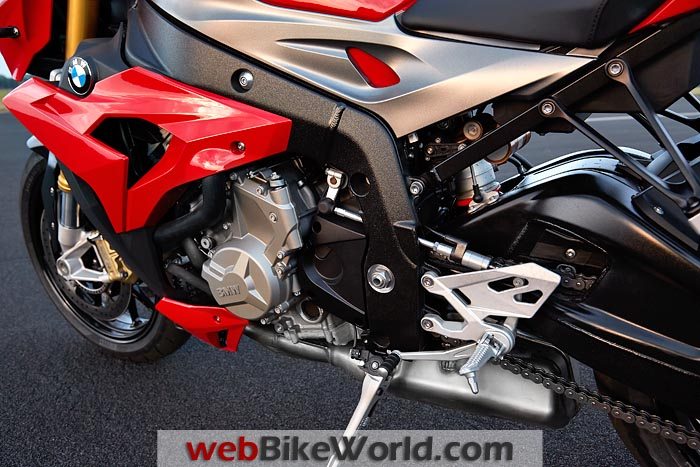
Aluminum wheels.
The dynamic persona of the new S 1000 R is also mirrored in the styling of its wheels. These intricate, dynamically styled 10-spoke die-cast aluminum wheels are also used on the S 1000 RR.
In the quest for the lightest possible design, the brake discs are not separately mounted, which would involve additional bolted connections. Instead, the brake disc rings are directly mounted to the specially designed wheel hub.
The special design of these wheels means they are still among the lightest in their segment. Sizes are 120/70 ZR 17 at the front and 190/55 ZR 17 at the rear.
High-performance brakes, partially integral Race ABS and steering damper standard.
The new S 1000 R’s brake system has been directly adopted from the S 1000 RR superbike and is therefore fully matched to the high-performance drivetrain and suspension.
Front braking is provided by a twin-disc brake with two radial four-piston fixed calipers and two floating steel brake discs with 320-millimetre diameter and 5-millimetre thickness.
The steel-mesh-wrapped, pressure-resistant brake lines provide optimal transmission of the braking power from the hand-operated brake lever.
Rear braking is provided by a hydraulically actuated single-disc brake with single-piston floating caliper. The rigidly mounted steel brake disc has a diameter of 220 millimeters and a thickness of 5 millimeters.
Here too, steel-mesh-wrapped brake lines are used.
A very clear pressure point, excellent braking action, clearly controllable modulation plus maximum temperature stability are hallmarks of the S 1000 R brake system not only on the road but also, when required, on the race track.
Standard partially integral BMW Motorrad Race ABS.
With this system, the handbrake controls both the front and the rear wheel brakes, and the footbrake lever controls just the rear wheel brake.
In conjunction with the rider-selectable riding modes, three different Race ABS characteristics are also selected. These are combined with and — for maximum safety– fully synchronized with the riding modes.
With a weight of just 1.56 kg for the controller and a total weight of less than 2.5 kg, this system is among the lightest in the market. For special requirements, Race ABS can be separately deactivated.
Although Race ABS is a valuable support for the rider and provides huge safety benefits when braking, it can only act within the laws of physics.
It is still possible to fall foul of these laws through rider misjudgments or errors, which in extreme cases can result in a fall.
Race ABS does, however, help the rider to use the braking performance of the S 1000 R significantly more efficiently and therefore more safely. The new S 1000 R is also equipped with a steering damper.
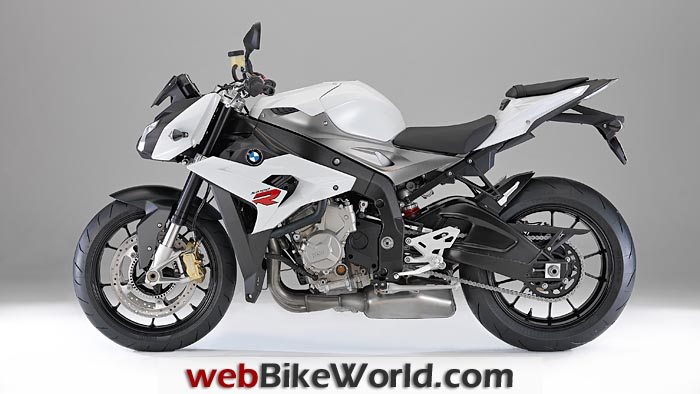
Electrics and electronics.
The instrument cluster of the S 1000 R features a large liquid crystal display and an analogue, easy-to-read rev counter.
As well as the currently engaged gear, the currently selected riding mode (“Rain”, “Road”, “Dynamic” or “Dynamic Pro”) is also displayed.
It is possible, using the control at the right-hand end of the handlebars, to switch between the different riding modes either while stationary or on the fly, provided the accelerator twist grip is shut down first.
The instrument cluster of the S 1000 R offers an unrivalled range of functions in this segment.
For example, the rider can switch the display to track mode in order to see details of the current, best or last lap time.
It is even possible to display the time, per lap, for which the brakes were applied, the accelerator position in percentage per lap and the number of gear shifts per lap.
If the HP infrared lap timer special accessory is specified, riders can also make precise time measurements for subsequent data analysis.
A quick-shifter, which is adjustable for brightness, frequency (4 and 8 Hz) and for choice of shift points in the range 7,000 rpm to 12,000 rpm, allows the rider to hit the shift point very precisely.
The instrument cluster comprises the following displays: rev counter, speedometer, gear display, riding mode, total mileage, engine temperature and fuel level with remaining range (from start of trip).
Also Trip 1, Trip 2, average fuel consumption, average speed, lap timer, quick-shifter, time of day, best lap in progress.
If the relevant options have been specified, also: heated grips, DDC and cruise control.
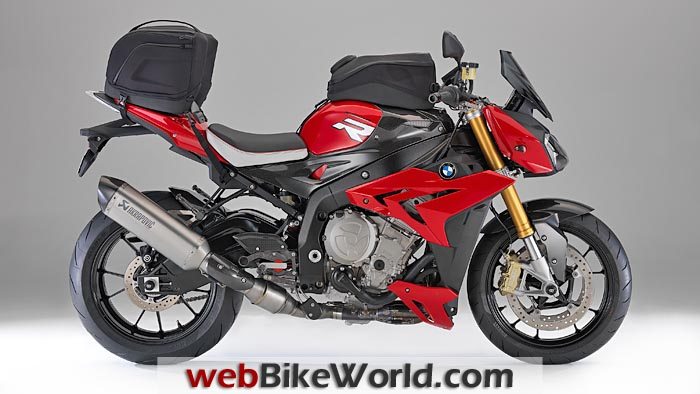
Dynamic design and sporty ergonomics.
In its design idiom too, the new S 1000 R shows clear similarities with its superbike counterpart, the S 1000 RR, although in this case the styling is molded to the requirements of a sports roadster.
Visually, the S 1000 R stands out very clearly from its competitors and its “tail up – nose down” stance gives it a particularly aggressive, dynamic look.
The low front end and a high tail that is even more striking than on the RR, give the S 1000 R a look of grace and effortlessness. The deep headlight cover and the high, angular tail suggest an animal about to spring.
In front view, the asymmetrical headlights and the large central air intake are clear evidence of the DNA inherited from the RR.
The new S 1000 R also offers an instantly recognizable and unmistakable front view and is a face that stands out from the crowd.
Compared with the S 1000 RR superbike, the design language of the S 1000 R is much more pared down and sharply defined.
For example, the opening on the cooling air exit side is even more powerfully styled and dynamic on the S 1000 R, while on the left side too, gill-shaped air outlets create an even more defined and dynamic look.
The covers of the airbox and aluminum tank also received new treatment and are neatly integrated into the overall design.
On the S 1000 R, as well as sportiness and dynamism, development also focused on one of the traditional virtues of BMW motorcycle design: perfect ergonomics.
With its low seat height of 814 mm, the S 1000 R is well suited to all roadster fans.
A wide, tapering, aluminum handlebar with forged handlebar clamp brackets makes for a relaxed upper body posture and the redefined footrest positions result in a leg position which is both sporty and also comfortable.
As a result, the S 1000 R provides a relaxed seating position for sporty riding on the open road which is nevertheless comfortable on long-distance trips.
Color Scheme
The sporty and dynamic personality of the new BMW S 1000 R is echoed in the three different color schemes.
The S 1000 R is available in Racing red non-metallic, Frozen dark blue metallic and Light white non-metallic paintwork.
Racing red non-metallic paintwork gives the new S 1000 R a particularly sporty and aggressive appearance.
With the prominently positioned “R” logo on the fuel tank, it underlines the bike’s status as a top performer in the sports roadster segment.
Frozen dark blue metallic stresses the elegant, high-tech character of the S 1000 R. Here sportiness and dynamism are combined with a sumptuousness that shows off the bike’s engineering to maximum effect.
With Light white non-metallic paintwork, the new S 1000 R takes the corporate design colors of BMW Motorrad as its inspiration and combines sportiness with refinement.
This paint scheme gives the sporty roadster a particularly light and agile appearance.
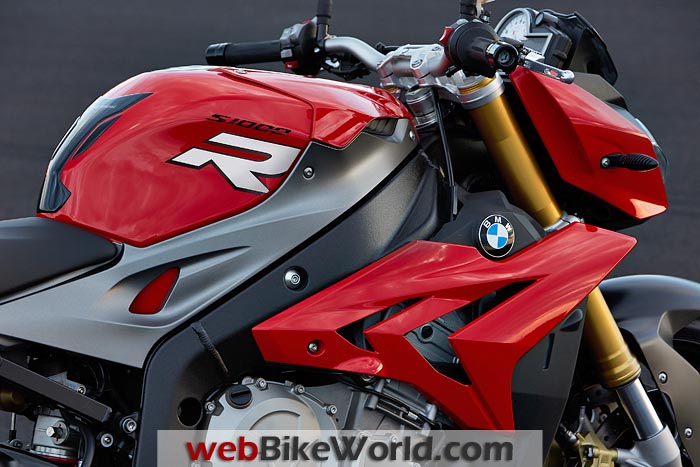
Optional Equipment and Accessories
For additional customization, the S 1000 R is available with the usual extensive range of BMW Motorrad optional equipment and special accessories.
Optional equipment items are supplied directly ex-works and are integrated in the production process. Special accessories can be retrofitted by the BMW Motorrad dealer or customers themselves.
Options:
- Sports package with Dynamic Traction Control (DTC), Riding mode Pro (“Dynamic”, “Dynamic Pro”), gear shift assistant and cruise control.
- Dynamic package with Dynamic Damping Control (DDC), heated grips, LED direction indicators and small engine spoiler in bike color.
Safety and Performance Special Accessories:
- DTC and Riding mode Pro.
- Cruise control.
- Engine crash pads.
- Axle sliders.
- Anti-theft alarm system.
- Storage:
- Tank rucksack. Rear bag.
Design:
- HP Carbon tank cover left/right.
- HP Carbon airbox cover.
- HP Carbon front mudguard.
- HP Carbon rear mudguard.
- HP Carbon chain guard.
- Tail cover.
- Engine spoiler.
- HP Race Cover Kit.
- HP full titanium exhaust system (4.5 kg lighter than the standard system). Akrapovič sports silencer.
Ergonomics and Comfort:
- HP Race footrest plate.
- HP Race rider footrest system.
- HP pillion footrests.
- HP gear shift assistant.
- HP folding clutch lever.
- HP folding handbrake lever.
- Sport windscreen.
- Rider’s comfort seat.
- Pillion seat with enhanced comfort.
- Heated grips.
Navigation and Communication:
- BMW Motorrad Navigator; Navigator cradle, cable and mounting kit.
Maintenance and Technology:
- HP lap timer.
- HP Race data logger.
- HP forged wheels.
- Sport work stand.
- Swingarm adapter for Sport work stand.
- Motorcycle cover.
- HP tire warmers.
- HP brake remote adjustment.
- HP Race pit-stop carpet.
Rider’s Accessories:
- Race helmet, Sport suit, Sport boots and 2-in-1 gloves.
Pricing
As of the date of publication, pricing for the U.S.A. has not been announced.
2014 BMW S 1000 R Specifications
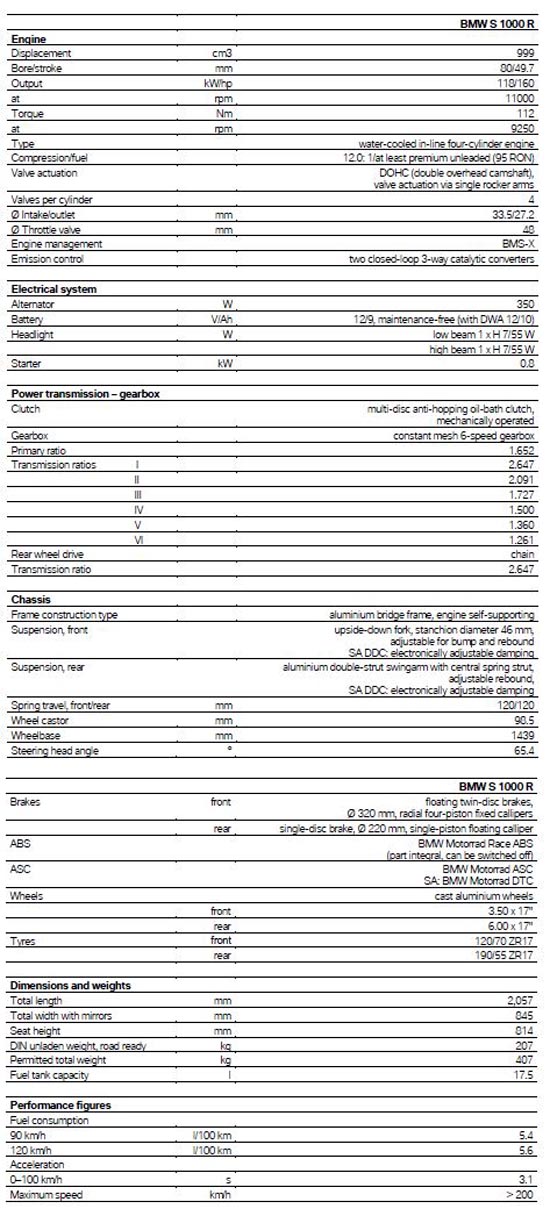
2014 BMW S 1000 R Horsepower and Torque Curves
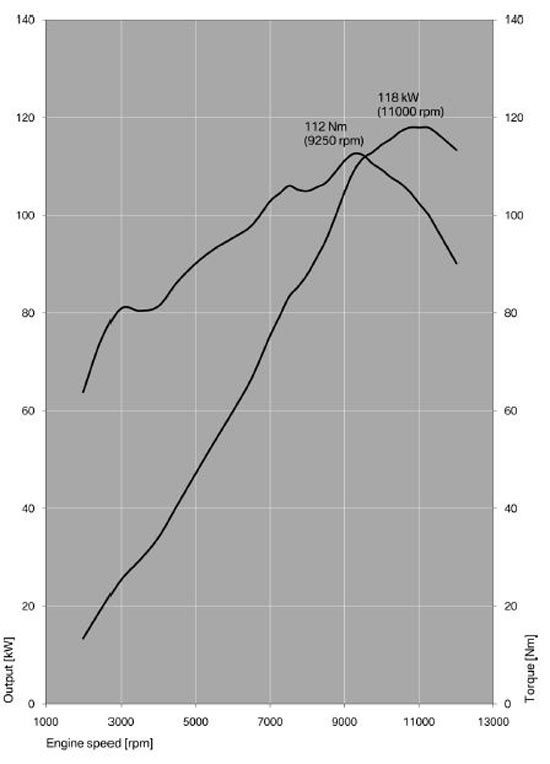
More: 2014 BMW Motorcycles | wBW BMW Motorcycles Page
Owner Comments and Feedback
See details on submitting comments.



No Comment